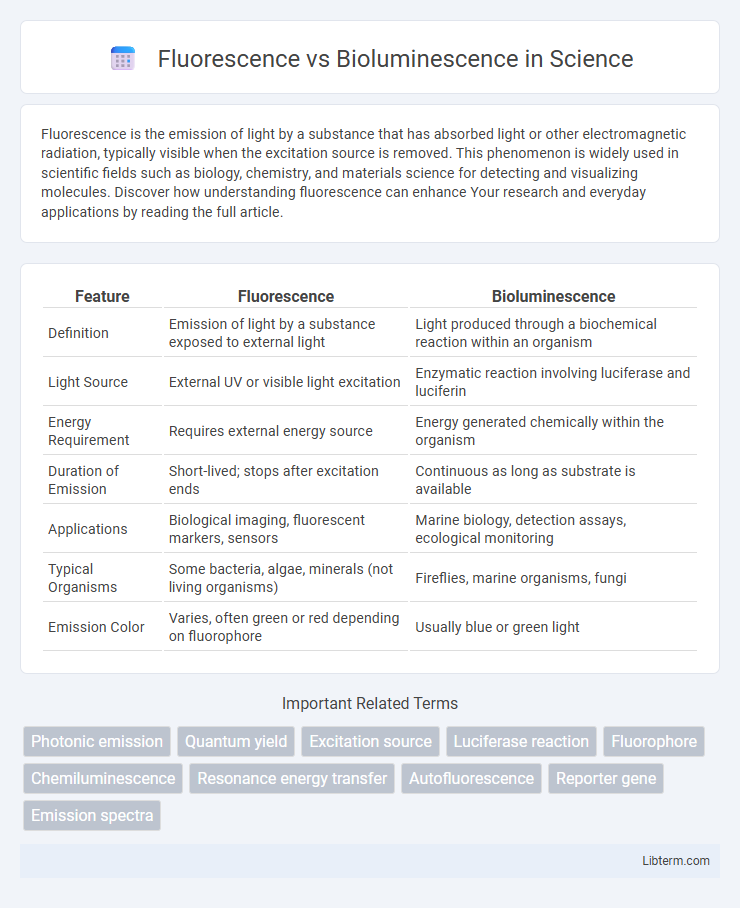Fluorescence is the emission of light by a substance that has absorbed light or other electromagnetic radiation, typically visible when the excitation source is removed. This phenomenon is widely used in scientific fields such as biology, chemistry, and materials science for detecting and visualizing molecules. Discover how understanding fluorescence can enhance Your research and everyday applications by reading the full article.
Table of Comparison
| Feature | Fluorescence | Bioluminescence |
|---|---|---|
| Definition | Emission of light by a substance exposed to external light | Light produced through a biochemical reaction within an organism |
| Light Source | External UV or visible light excitation | Enzymatic reaction involving luciferase and luciferin |
| Energy Requirement | Requires external energy source | Energy generated chemically within the organism |
| Duration of Emission | Short-lived; stops after excitation ends | Continuous as long as substrate is available |
| Applications | Biological imaging, fluorescent markers, sensors | Marine biology, detection assays, ecological monitoring |
| Typical Organisms | Some bacteria, algae, minerals (not living organisms) | Fireflies, marine organisms, fungi |
| Emission Color | Varies, often green or red depending on fluorophore | Usually blue or green light |
Introduction to Fluorescence and Bioluminescence
Fluorescence is the emission of light by a substance that absorbs light or other electromagnetic radiation, typically visible when exposed to ultraviolet or blue light, and occurs rapidly as electrons return to their ground state. Bioluminescence, on the other hand, is the natural production of light by living organisms such as fireflies and certain marine animals, generated through a chemical reaction involving the enzyme luciferase. Both phenomena involve light emission but differ fundamentally in their energy sources and biological functions.
Defining Fluorescence: Mechanism and Characteristics
Fluorescence occurs when molecules absorb high-energy photons, typically ultraviolet or blue light, and quickly re-emit photons at a longer wavelength, visible as bright colors. This process involves the excitation of electrons to a higher energy state followed by a rapid return to the ground state, emitting light generally within nanoseconds. Key characteristics of fluorescence include its dependence on an external light source for excitation and the emission of light only while the excitation source is present, distinguishing it from bioluminescence.
Unpacking Bioluminescence: How It Works
Bioluminescence is a natural process where living organisms produce light through a chemical reaction involving the enzyme luciferase acting on the substrate luciferin, emitting photons without requiring external light excitation. This reaction typically occurs in marine species like dinoflagellates, jellyfish, and fireflies, enabling functions such as camouflage, mating signals, or predation. Unlike fluorescence, which depends on absorbed light to reemit at a different wavelength, bioluminescence generates light intrinsically through metabolic processes.
Key Differences Between Fluorescence and Bioluminescence
Fluorescence occurs when a substance absorbs light at one wavelength and emits it at a longer wavelength almost instantaneously, relying on external light sources like UV rays. Bioluminescence is a chemical process where living organisms produce light through enzymatic reactions, such as the luciferase-luciferin system, without requiring external light. Key differences include energy source dependency, duration of light emission, and biological context, with fluorescence being photophysical and bioluminescence being biochemical.
Natural Examples of Fluorescence
Fluorescence occurs when organisms absorb light at one wavelength and emit it at a longer wavelength, as seen in coral reefs where fluorescent proteins emit vibrant colors under UV light. Many marine animals, such as certain fish and jellyfish, display natural fluorescence to communicate or camouflage in their environment. These natural examples of fluorescence differ from bioluminescence, which involves chemical reactions producing light without external light stimulation.
Natural Examples of Bioluminescence
Bioluminescence naturally occurs in marine organisms like the deep-sea anglerfish, which uses a light-emitting lure to attract prey in dark ocean depths. Fireflies produce bioluminescent light through a chemical reaction in their abdomens to communicate and attract mates during the night. Certain fungi, such as species in the genus *Armillaria*, emit a faint, greenish glow to possibly deter predators or attract insects for spore dispersal.
Scientific Applications of Fluorescence
Fluorescence is extensively used in scientific applications such as bioimaging, molecular diagnostics, and flow cytometry due to its ability to emit light upon excitation by specific wavelengths, enabling high-resolution visualization of cellular structures and biomolecules. Its sensitivity and specificity facilitate real-time tracking of biochemical processes, while fluorescent probes and dyes enhance detection accuracy in medical and environmental research. Bioluminescence, though valuable for in vivo imaging and reporter assays, lacks the excitation source flexibility and spectral range that fluorescence provides, limiting its scope in detailed analytical studies.
Practical Applications of Bioluminescence
Bioluminescence finds practical applications in medical diagnostics through bioluminescent imaging, enabling real-time visualization of cellular and molecular processes. This natural light emission is also utilized in environmental monitoring to detect pollution or toxins by measuring changes in bioluminescent organisms' intensity. In biotechnology, bioluminescence assists in high-throughput drug screening and genetic research by serving as a sensitive reporter system.
Advantages and Limitations of Each Phenomenon
Fluorescence provides high sensitivity and spatial resolution, making it ideal for imaging applications due to its rapid excitation and emission cycles, but it requires external light sources which can lead to photobleaching and background noise. Bioluminescence offers superior signal-to-noise ratio and does not depend on external illumination, allowing for deeper tissue imaging and reduced phototoxicity, yet it is limited by lower brightness and slower photon emission rates. Both phenomena are widely used in molecular biology and medical diagnostics, with fluorescence favored for real-time tracking and bioluminescence preferred for in vivo studies.
Future Perspectives in Fluorescence and Bioluminescence Research
Future perspectives in fluorescence and bioluminescence research emphasize advancements in molecular imaging technologies and novel probe development, aiming to enhance sensitivity and specificity in biomedical diagnostics. Emerging techniques such as near-infrared fluorescence and genetically encoded bioluminescent reporters hold promise for real-time, non-invasive monitoring of cellular and molecular processes in vivo. Integration with artificial intelligence and nanotechnology is expected to drive breakthroughs in personalized medicine, environmental sensing, and drug discovery.
Fluorescence Infographic

 libterm.com
libterm.com